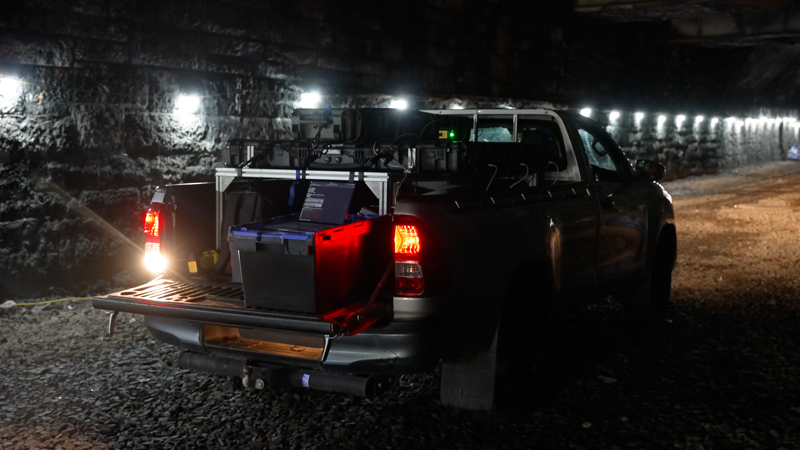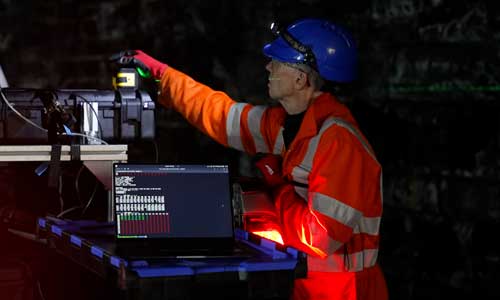Cosmic rays from space used to uncover secrets of Victorian railway tunnel
Cosmic ray technology used to find hidden chambers in the Great Pyramid at Giza is helping us to unlock the secrets of a historic railway tunnel located deep under the streets of Glasgow.

Share this article
Published
01 Nov 2022Balgray Tunnel, constructed in 1896, curves for 640 metres under the busy Kelvinside area of Glasgow and although it has been closed since 1964 it still needs regular inspections to ensure it remains safe and in good order.
Until now techniques such as ground penetrating radar, drilling and visual inspections have been used to check for hidden shafts and highlight potential issues.
Now a novel process called muon imaging, which harnesses cosmic rays from space to create powerful x-ray like images, is being used to search for potential defects and voids without having to be in physical contact with the tunnel walls and ceiling - so avoiding the need for access at height.
We're working with Hampshire-based tech company Geoptic for the trial at Balgray Tunnel, one of more than 3,000 former railway structures maintained by our Historical Railways Estate (HRE) on behalf of owners, the Department for Transport.
Geoptic has adapted the muon process for use in railway tunnels and the Balgray survey is the first time the technology has been used on an HRE tunnel.
Head of the HRE programme Helene Rossiter said:
“Ensuring all our structures remain safe and in good maintenance is our priority and we’re very eager to see the results of this unique technique and evaluate how it might help us carry out some of our tunnel surveys more efficiently in the future.
“Inspections of all our historic railway tunnels are a key part of the maintenance routine and if the Balgray Tunnel trial is successful we could look to use the technology in other tunnel surveys in the HRE.”

(Professor Lee Thompson carries out the muon survey in the tunnel)
Muon tomography relies on cosmic rays which are high-energy particles produced by the sun and other astronomical sources that hurtle through space at close to the speed of light. As they enter the earth’s atmosphere they collide with the oxygen and nitrogen molecules which triggers a cascade of other particles. Most of these particles are stopped in the atmosphere but muons particles make it to the ground.
A muon is 200 times heavier than an electron and its weight and speed give it an advantage over x-rays in penetrating dense materials. At sea level there are around 10,000 muons passing through every square metre of ground every minute and these can be used to image the interior of large engineering infrastructure.
Muons can penetrate through hundreds of metres of materials such as brick, rock and concrete.
In 2017 the technology was used to survey the Great Pyramid at Giza, which led to the discovery of secret chambers and rooms untouched by human hands since the Pyramid was built over 4500 years ago. The biggest discovery was a 100-feet-long void above the grand gallery. More surveys are planned this year.
Muon tomography has also been used to search for magma chambers inside active volcanoes and image the Fukushima nuclear reactors.
Prof Lee Thompson, Geoptic’s Technical Director, said:
“Geoptic is delighted to be working with National Highways to provide the first HRE muon tunnel survey and we hope this is a collaboration we will be able to continue in the future.
“Before the survey started, we needed to develop a digital twin of the tunnel using detailed geological data which informs us how many muons we expect to see at any point in the tunnel. Then, inside the tunnel, we use our instruments that detect muons to measure the number of muons at different points.
“Differences between what we expect to see and what we actually observe can be interpreted as differences in density in the structure of the tunnel compared with that we assumed in our digital twin. As well as identifying hidden voids and shafts our instruments can return valuable information on the shaft position, size and extent.”
During the Victorian era engineers constructed shafts along the line of a tunnel to speed up the construction process and help maintain the tunnel's alignment; particularly on curves.
When a tunnel was completed some of the shafts would be kept for ventilation and others capped at both ends or back-filled and assumed stable. Being able to locate and survey hidden closed shafts and other voids in the structure is important for maintenance and safety of the tunnel.
Balgray Tunnel is located between the former Kelvinside station and Bellshaugh Junctions and was part of the Lanarkshire and Dunbartonshire Railway, which originally ran from Possil to Dumbarton but is now almost all abandoned.
The results of the survey are currently being assessed to see if future works will be planned.
Find out more about the Balgray Tunnel project.
